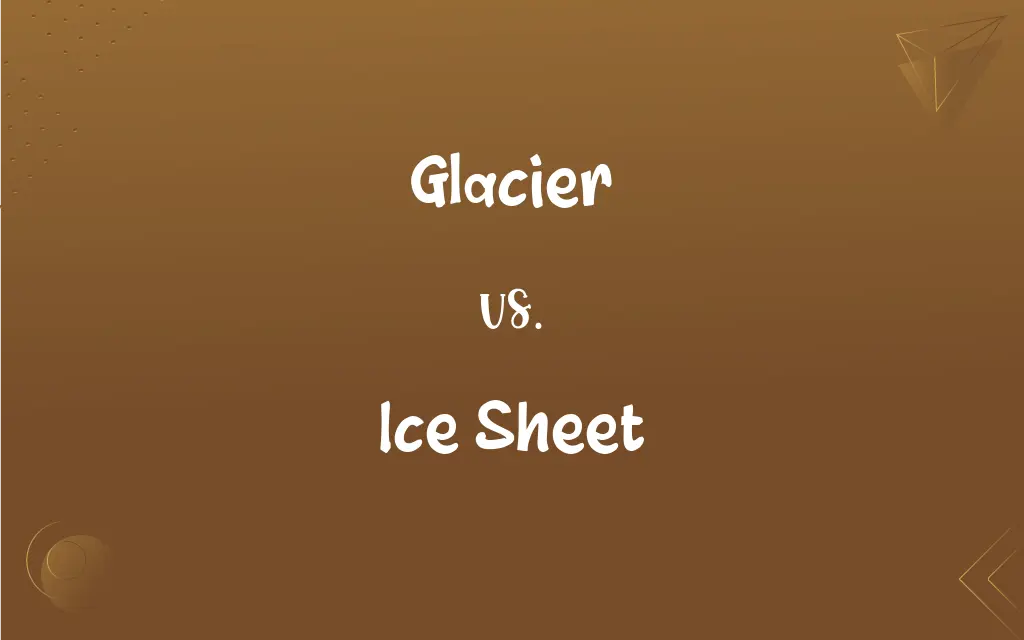Glacier vs. Ice Sheet: What's the Difference?
Edited by Aimie Carlson || By Janet White || Published on November 5, 2023
A glacier is a slow-moving mass of ice, while an ice sheet is a vast, continent-sized glacier.

Key Differences
Glaciers are rivers of ice, formed in areas where snow accumulation exceeds melting; Ice Sheets are colossal, covering extensive areas, including entire continents.
Glaciers are found on every continent, shaping landscapes; Ice Sheets are exclusive to Greenland and Antarctica, influencing global climate.
Glaciers move under their own weight, carving valleys; Ice Sheets are thick, continuous expanses of ice, dwarfing individual glaciers.
Glaciers vary in size, from small cirque glaciers to large valley ones; Ice Sheets are uniform in their vastness, enveloping terrain beneath.
Glaciers contribute to sea-level rise through melting; Ice Sheets, due to their sheer size, have a more significant impact on sea levels.
ADVERTISEMENT
Comparison Chart
Size
Ranges from small to large
Vast, continent-sized
Location
Worldwide
Only in Greenland and Antarctica
Landscape Influence
Carves valleys, shapes mountains
Covers entire landscapes
Movement
Moves due to gravity
Also moves, but on a larger scale
Climate Impact
Influences local climate
Has significant global climate implications
ADVERTISEMENT
Glacier and Ice Sheet Definitions
Glacier
Climate Indicator
The glacier's retreat indicates climate change.
Ice Sheet
Thick Layer
The ice sheet is several kilometers thick.
Glacier
Moving Ice
The glacier slowly carved the valley.
Ice Sheet
Vast Ice Cover
The Antarctic ice sheet covers an entire continent.
Glacier
Varied Sizes
We hiked beside a small cirque glacier.
Ice Sheet
Global Impact
The melting ice sheet affects global sea levels.
Glacier
Landscape Shaper
The glacier shaped the mountain's contours.
Ice Sheet
Cold Region Feature
Ice sheets are unique to polar regions.
Glacier
Formed from Snow
Years of snow accumulation formed the glacier.
Ice Sheet
Climate Archive
Ice sheets hold valuable climate data in their layers.
Glacier
A huge mass of ice slowly flowing over a landmass, formed from compacted snow in an area where snow accumulation has exceeded melting and sublimation.
Glacier
(geology) A large body of ice which flows under its own mass, usually downhill.
They warned that the effects of glacier melting on water resources are becoming “increasingly serious” for China.
Glacier
An immense field or stream of ice, formed in the region of perpetual snow, and moving slowly down a mountain slope or valley, as in the Alps, or over an extended area, as in Greenland.
Glacier
A slowly moving mass of ice
FAQs
Can glaciers be small?
Yes, they range in size.
What is a glacier?
A slow-moving mass of ice.
What is an ice sheet?
A vast, continent-sized glacier.
Where are glaciers found?
Worldwide, on every continent.
Where are ice sheets found?
Only in Greenland and Antarctica.
Do glaciers shape the landscape?
Yes, they carve valleys and shape mountains.
What impact do ice sheets have?
Significant global climate implications.
Do ice sheets hold climate data?
Yes, in their layered ice.
Are all glaciers part of ice sheets?
No, they are independent formations.
How thick can ice sheets be?
Several kilometers thick.
Are glaciers important for climate studies?
Yes, they are climate indicators.
Is an ice sheet a type of glacier?
Yes, it's a large-scale glacier.
Are ice sheets permanent features?
They are relatively stable but can change with climate.
Do glaciers move?
Yes, they flow slowly.
How large are ice sheets?
Extremely large, covering entire continents.
Do glaciers only form from snow?
Primarily, though other factors contribute.
What is the main difference between them?
Scale and distribution: glaciers vary in size and are widespread, while ice sheets are enormous and limited to polar regions.
Can a glacier become an ice sheet?
No, they are distinct entities.
How do ice sheets affect sea levels?
Their melting contributes significantly to sea-level rise.
Can glaciers exist in warm regions?
Yes, even in temperate zones.
About Author
Written by
Janet WhiteJanet White has been an esteemed writer and blogger for Difference Wiki. Holding a Master's degree in Science and Medical Journalism from the prestigious Boston University, she has consistently demonstrated her expertise and passion for her field. When she's not immersed in her work, Janet relishes her time exercising, delving into a good book, and cherishing moments with friends and family.
Edited by
Aimie CarlsonAimie Carlson, holding a master's degree in English literature, is a fervent English language enthusiast. She lends her writing talents to Difference Wiki, a prominent website that specializes in comparisons, offering readers insightful analyses that both captivate and inform.






































































